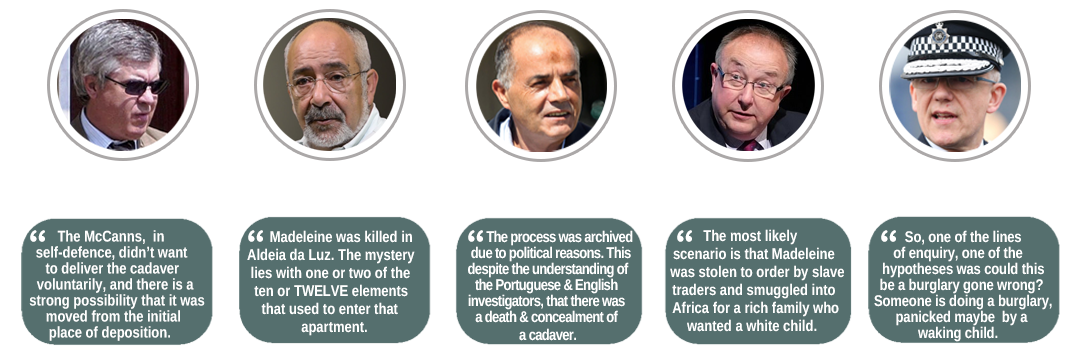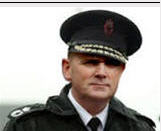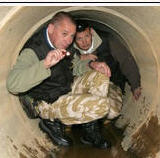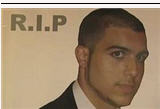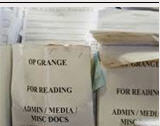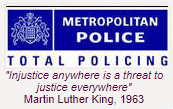The Devious Art Of Lying By Telling The Truth
Page 1 of 1 • Share
 The Devious Art Of Lying By Telling The Truth
The Devious Art Of Lying By Telling The Truth
The devious art of lying by telling the truth
By Melissa Hogenboom -15 November 2017
It is no secret that politicians often lie, but consider this – they can do so simply by telling the truth. Confused?
That statement becomes clearer when you realise that we've probably all done it. A classic example might be if your mum asks if you've finished your homework and you respond: "I've written an essay on Tennessee Williams for my English class." This may be true, but it doesn't actually answer the question about whether your homework was done. That essay could have been written long ago and you have misled your poor mother with a truthful statement. You might not have even started your homework yet.
Misleading by "telling the truth" is so pervasive in daily life that a new term has recently been coined to describe it: paltering. That it is so widespread in society now gives us more insight into the grey area between truth and lies, and perhaps even why we lie at all.
We lie all the time, despite the fact that it costs us considerably more mental effort to lie than to tell the truth. US president Abraham Lincoln once said that "no man has a good enough memory to be a successful liar".
In 1996 one researcher, Bella DePaulo even put a figure on it. She found that each of us lies about once or twice a day. She discovered this by asking participants for one week to note down each time they lied, even if they did so with a good intention. Out of the 147 participants in her original study, only seven said they didn’t lie at all - and we can only guess if they were telling the truth.
Many of the lies were fairly innocent, or even kind, such as: "I told her that she looked good when I thought that she looked like a blimp." Some were to hide embarrassment, such as pretending a spouse had not been fired. DePaulo, a psychologist at the University of California Santa Barbara, says that the participants in her study were not aware of how many lies they told, partly because most were so "ordinary and so expected that we just don't notice them".
It is when individuals use lies to manipulate others or to purposely mislead that it is more worrying. And this happens more often than you might think.
When Todd Rogers and his colleagues were looking at how often politicians dodge questions during debates they realised something else was going on. By stating another truthful fact, they could get out of answering a question. They could even imply something was truthful when it was not. Politicians do this all the time, says Rogers, a behavioural scientist at Harvard Kennedy School. He and colleagues therefore set out to understand more about it.
He found that paltering was an extremely common tactic of negotiation. Over half the 184 business executives in his study admitted to using the tactic. The research also found that the person doing the paltering believed it was more ethical than lying outright.
The individuals who had been deceived, however, did not distinguish between lying and paltering. "It probably leads to too much paltering as communicators think that when disclosed, it will be somewhat ethical, whereas listeners see it as a lie," says Rogers.
It is also difficult to spot a misleading "fact" when we hear something that on the face of it, sounds true. For instance, the UK's Labour Party campaign video to lower the voting age said: "You're 16. Now you can get married, join the Army, work full-time." The BBC's reality check team discovered that these facts do not tell the whole truth.
"You can only join the Army aged 16 or 17 with your parents' permission,” the Reality Check team wrote. “At that age you also need your parents' permission to get married unless you do so in Scotland. Since 2013, 16 and 17-year-olds cannot work full-time in England, but can in the other three home nations with some restrictions."
In another example, the then-presidential-nominee Donald Trump paltered during the presidential debates. He was questioned about a housing discrimination lawsuit early on in his career and stated that his company had given "no admission of guilt". While they may not have admitted it, an investigation by the New York Times found that his company did discriminate based on race.
And even if we do spot misleading truths, social norms can prevent us from challenging whether or not they are deceptive. Take a now infamous interview in the UK, where journalist Jeremy Paxman interviewed the politician Michael Howard (pictured below). He repeatedly asks Howard whether he "threatened to overrule" the then prisons governor. Howard in turn, continues to evade the question with other facts in a bizarre exchange that becomes increasingly awkward to watch. Not many of us are comfortable challenging someone in that way.
While it's common in politics, so too is it in everyday life. Consider the estate agent who tells a potential buyer that an unpopular property has had "lots of enquiries" when asked how many actual bids there have been. Or the used car salesman who says a car started up extremely well on a frosty morning, without disclosing that it broke down the week before. Both statements are true but mask the reality of the unpopular property and the dodgy car.
Paltering is perhaps so commonplace because it is seen as a useful tool. It happens because we constantly have so many competing goals, suggests Rogers. "We want to achieve our narrow objective – [selling a house or car] – but we also want people to see us as ethical and honest." He says these two goals are in tension and by paltering, people believe they are being more ethical than outright lying. "We show evidence they are making a mistake," says Rogers.
We can see the problems this sort of thinking can cause reflected in society today. The public are clearly sick of being lied to and trust in politicians is plummeting. One 2016 poll found that the British public trust politicians less than estate agents, bankers and journalists.
And despite the fact that we now frequently expect lies from those in power, it remains challenging to spot them in real time, especially so if they lie by paltering. Psychologist Robert Feldman, author of The Liar in Your Life, sees this as worrying both on a personal and on a macro level. "When we're lied to by people in power, it ruins our confidence in political institutions – it makes the population very cynical about [their] real motivations."
Lying can and does clearly serve a devious social purpose. It can help someone paint a better picture than the truth, or help a politician dodge an uncomfortable question. "It's unethical and it makes our democracy worse. But it's how human cognition works," says Rogers.
Unfortunately, the prevalence of lies might stem from the way we are brought up. Lies play a role in our social interactions from a very young age. We tell young children about tooth fairies and Santa, or encourage a child to be grateful for an unwanted present. "We give our kids very mixed messages," says Feldman. "What they ultimately learn is that even though honesty is the best policy, it's also at times fine and preferable to lie about things."
So next time you hear a fact that sounds odd, or someone to be deflecting a question, be aware that what you think is the truth may very well be deceptive.
http://www.bbc.com/future/story/20171114-the-disturbing-art-of-lying-by-telling-the-truth
Food for thought?
By Melissa Hogenboom -15 November 2017
It is no secret that politicians often lie, but consider this – they can do so simply by telling the truth. Confused?
That statement becomes clearer when you realise that we've probably all done it. A classic example might be if your mum asks if you've finished your homework and you respond: "I've written an essay on Tennessee Williams for my English class." This may be true, but it doesn't actually answer the question about whether your homework was done. That essay could have been written long ago and you have misled your poor mother with a truthful statement. You might not have even started your homework yet.
Misleading by "telling the truth" is so pervasive in daily life that a new term has recently been coined to describe it: paltering. That it is so widespread in society now gives us more insight into the grey area between truth and lies, and perhaps even why we lie at all.
We lie all the time, despite the fact that it costs us considerably more mental effort to lie than to tell the truth. US president Abraham Lincoln once said that "no man has a good enough memory to be a successful liar".
In 1996 one researcher, Bella DePaulo even put a figure on it. She found that each of us lies about once or twice a day. She discovered this by asking participants for one week to note down each time they lied, even if they did so with a good intention. Out of the 147 participants in her original study, only seven said they didn’t lie at all - and we can only guess if they were telling the truth.
Many of the lies were fairly innocent, or even kind, such as: "I told her that she looked good when I thought that she looked like a blimp." Some were to hide embarrassment, such as pretending a spouse had not been fired. DePaulo, a psychologist at the University of California Santa Barbara, says that the participants in her study were not aware of how many lies they told, partly because most were so "ordinary and so expected that we just don't notice them".
It is when individuals use lies to manipulate others or to purposely mislead that it is more worrying. And this happens more often than you might think.
When Todd Rogers and his colleagues were looking at how often politicians dodge questions during debates they realised something else was going on. By stating another truthful fact, they could get out of answering a question. They could even imply something was truthful when it was not. Politicians do this all the time, says Rogers, a behavioural scientist at Harvard Kennedy School. He and colleagues therefore set out to understand more about it.
He found that paltering was an extremely common tactic of negotiation. Over half the 184 business executives in his study admitted to using the tactic. The research also found that the person doing the paltering believed it was more ethical than lying outright.
The individuals who had been deceived, however, did not distinguish between lying and paltering. "It probably leads to too much paltering as communicators think that when disclosed, it will be somewhat ethical, whereas listeners see it as a lie," says Rogers.
It is also difficult to spot a misleading "fact" when we hear something that on the face of it, sounds true. For instance, the UK's Labour Party campaign video to lower the voting age said: "You're 16. Now you can get married, join the Army, work full-time." The BBC's reality check team discovered that these facts do not tell the whole truth.
"You can only join the Army aged 16 or 17 with your parents' permission,” the Reality Check team wrote. “At that age you also need your parents' permission to get married unless you do so in Scotland. Since 2013, 16 and 17-year-olds cannot work full-time in England, but can in the other three home nations with some restrictions."
In another example, the then-presidential-nominee Donald Trump paltered during the presidential debates. He was questioned about a housing discrimination lawsuit early on in his career and stated that his company had given "no admission of guilt". While they may not have admitted it, an investigation by the New York Times found that his company did discriminate based on race.
And even if we do spot misleading truths, social norms can prevent us from challenging whether or not they are deceptive. Take a now infamous interview in the UK, where journalist Jeremy Paxman interviewed the politician Michael Howard (pictured below). He repeatedly asks Howard whether he "threatened to overrule" the then prisons governor. Howard in turn, continues to evade the question with other facts in a bizarre exchange that becomes increasingly awkward to watch. Not many of us are comfortable challenging someone in that way.
While it's common in politics, so too is it in everyday life. Consider the estate agent who tells a potential buyer that an unpopular property has had "lots of enquiries" when asked how many actual bids there have been. Or the used car salesman who says a car started up extremely well on a frosty morning, without disclosing that it broke down the week before. Both statements are true but mask the reality of the unpopular property and the dodgy car.
Paltering is perhaps so commonplace because it is seen as a useful tool. It happens because we constantly have so many competing goals, suggests Rogers. "We want to achieve our narrow objective – [selling a house or car] – but we also want people to see us as ethical and honest." He says these two goals are in tension and by paltering, people believe they are being more ethical than outright lying. "We show evidence they are making a mistake," says Rogers.
We can see the problems this sort of thinking can cause reflected in society today. The public are clearly sick of being lied to and trust in politicians is plummeting. One 2016 poll found that the British public trust politicians less than estate agents, bankers and journalists.
And despite the fact that we now frequently expect lies from those in power, it remains challenging to spot them in real time, especially so if they lie by paltering. Psychologist Robert Feldman, author of The Liar in Your Life, sees this as worrying both on a personal and on a macro level. "When we're lied to by people in power, it ruins our confidence in political institutions – it makes the population very cynical about [their] real motivations."
Lying can and does clearly serve a devious social purpose. It can help someone paint a better picture than the truth, or help a politician dodge an uncomfortable question. "It's unethical and it makes our democracy worse. But it's how human cognition works," says Rogers.
Unfortunately, the prevalence of lies might stem from the way we are brought up. Lies play a role in our social interactions from a very young age. We tell young children about tooth fairies and Santa, or encourage a child to be grateful for an unwanted present. "We give our kids very mixed messages," says Feldman. "What they ultimately learn is that even though honesty is the best policy, it's also at times fine and preferable to lie about things."
So next time you hear a fact that sounds odd, or someone to be deflecting a question, be aware that what you think is the truth may very well be deceptive.
http://www.bbc.com/future/story/20171114-the-disturbing-art-of-lying-by-telling-the-truth
Food for thought?
____________________
“ The secret of life is honesty and fair dealing. If you can fake that, you've got it made" - Groucho Marx

Verdi- ex forum manager

- Posts : 34684
Activity : 41936
Likes received : 5932
Join date : 2015-02-02
Location : Flossery
 Re: The Devious Art Of Lying By Telling The Truth
Re: The Devious Art Of Lying By Telling The Truth
An oldie but goodie..
The best (and worst) ways to spot a liar.
By David Robson - 7 September 2015
Thomas Ormerod’s team of security officers faced a seemingly impossible task. At airports across Europe, they were asked to interview passengers on their history and travel plans. Ormerod had planted a handful of people arriving at security with a false history, and a made-up future – and his team had to guess who they were. In fact, just one in 1000 of the people they interviewed would be deceiving them. Identifying the liar should have been about as easy as finding a needle in a haystack.
So, what did they do? One option would be to focus on body language or eye movements, right? It would have been a bad idea. Study after study has found that attempts – even by trained police officers – to read lies from body language and facial expressions are more often little better than chance. According to one study, just 50 out of 20,000 people managed to make a correct judgement with more than 80% accuracy. Most people might as well just flip a coin.
Ormerod’s team tried something different – and managed to identify the fake passengers in the vast majority of cases. Their secret? To throw away many of the accepted cues to deception and start anew with some startlingly straightforward techniques.
Over the last few years, deception research has been plagued by disappointing results. Most previous work had focused on reading a liar’s intentions via their body language or from their face – blushing cheeks, a nervous laugh, darting eyes. The most famous example is Bill Clinton touching his nose when he denied his affair with Monica Lewinsky – taken at the time to be a sure sign he was lying. The idea, says Timothy Levine at the University of Alabama in Birmingham, was that the act of lying provokes some strong emotions – nerves, guilt, perhaps even exhilaration at the challenge – that are difficult to contain. Even if we think we have a poker face, we might still give away tiny flickers of movement known as “micro-expressions” that might give the game away, they claimed.
Yet the more psychologists looked, the more elusive any reliable cues appeared to be. The problem is the huge variety of human behaviour. With familiarity, you might be able to spot someone’s tics whenever they are telling the truth, but others will probably act very differently; there is no universal dictionary of body language. “There are no consistent signs that always arise alongside deception,” says Ormerod, who is based at the University of Sussex. “I giggle nervously, others become more serious, some make eye contact, some avoid it.” Levine agrees: “The evidence is pretty clear that there aren’t any reliable cues that distinguish truth and lies,” he says. And although you may hear that our subconscious can spot these signs even if they seem to escape our awareness, this too seems to have been disproved.
Despite these damning results, our safety often still hinges on the existence of these mythical cues. Consider the screening some passengers might face before a long-haul flight – a process Ormerod was asked to investigate in the run up to the 2012 Olympics. Typically, he says, officers will use a “yes/no” questionnaire about the flyer’s intentions, and they are trained to observe “suspicious signs” (such as nervous body language) that might betray deception. “It doesn’t give a chance to listen to what they say, and think about credibility, observe behaviour change – they are the critical aspects of deception detection,” he says. The existing protocols are also prone to bias, he says – officers were more likely to find suspicious signs in certain ethnic groups, for instance. “The current method actually prevents deception detection,” he says.
Clearly, a new method is needed. But given some of the dismal results from the lab, what should it be? Ormerod’s answer was disarmingly simple: shift the focus away from the subtle mannerisms to the words people are actually saying, gently probing the right pressure points to make the liar’s front crumble.
Ormerod and his colleague Coral Dando at the University of Wolverhampton identified a series of conversational principles that should increase your chances of uncovering deceit:
Use open questions. This forces the liar to expand on their tale until they become entrapped in their own web of deceit.
Employ the element of surprise. Investigators should try to increase the liar’s “cognitive load” – such as by asking them unanticipated questions that might be slightly confusing, or asking them to report an event backwards in time – techniques that make it harder for them to maintain their façade.
Watch for small, verifiable details. If a passenger says they are at the University of Oxford, ask them to tell you about their journey to work. If you do find a contradiction, though, don’t give yourself away – it’s better to allow the liar’s confidence to build as they rattle off more falsehoods, rather than correcting them.
Observe changes in confidence. Watch carefully to see how a potential liar’s style changes when they are challenged: a liar may be just as verbose when they feel in charge of a conversation, but their comfort zone is limited and they may clam up if they feel like they are losing control.
The aim is a casual conversation rather than an intense interrogation. Under this gentle pressure, however, the liar will give themselves away by contradicting their own story, or by becoming obviously evasive or erratic in their responses. “The important thing is that there is no magic silver bullet; we are taking the best things and putting them together for a cognitive approach,” says Ormerod.
Ormerod openly admits his strategy might sound like common sense. “A friend said that you are trying to patent the art of conversation,” he says. But the results speak for themselves. The team prepared a handful of fake passengers, with realistic tickets and travel documents. They were given a week to prepare their story, and were then asked to line up with other, genuine passengers at airports across Europe. Officers trained in Ormerod and Dando’s interviewing technique were more than 20 times more likely to detect these fake passengers than people using the suspicious signs, finding them 70% of the time.
“It’s really impressive,” says Levine, who was not involved in this study. He thinks it is particularly important that they conducted the experiment in real airports. “It’s the most realistic study around.”
The art of persuasion
Levine’s own experiments have proven similarly powerful. Like Ormerod, he believes that clever interviews designed to reveal holes in a liar’s story are far better than trying to identify tell-tale signs in body language. He recently set up a trivia game, in which undergraduates played in pairs for a cash prize of $5 for each correct answer they gave. Unknown to the students, their partners were actors, and when the game master temporarily left the room, the actor would suggest that they quickly peek at the answers to cheat on the game. A handful of the students took him up on the offer.
Afterwards, the students were all questioned by real federal agents about whether or not they had cheated. Using tactical questions to probe their stories – without focusing on body language or other cues – they managed to find the cheaters with more than 90% accuracy; one expert was even correct 100% of the time, across 33 interviews – a staggering result that towers above the accuracy of body language analyses. Importantly, a follow-up study found that even novices managed to achieve nearly 80% accuracy, simply by using the right, open-ended questions that asked, for instance, how their partner would tell the story.
Indeed, often the investigators persuaded the cheaters to openly admit their misdeed. “The experts were fabulously good at this,” says Levine. Their secret was a simple trick known to masters in the art of persuasion: they would open the conversation by asking the students how honest they were. Simply getting them to say they told the truth primed them to be more candid later. “People want to think of being honest, and this ties them into being cooperative,” says Levine. “Even the people who weren’t honest had difficulty pretending to be cooperative [after this], so for the most part you could see who was faking it.”
Clearly, such tricks may already be used by some expert detectives – but given the folklore surrounding body language, it’s worth emphasising just how powerful persuasion can be compared to the dubious science of body language. Despite their successes, Ormerod and Levine are both keen that others attempt to replicate and expand on their findings, to make sure that they stand up in different situations. “We should watch out for big sweeping claims,” says Levine.
Although the techniques will primarily help law enforcement, the same principles might just help you hunt out the liars in your own life. “I do it with kids all the time,” Ormerod says. The main thing to remember is to keep an open mind and not to jump to early conclusions: just because someone looks nervous, or struggles to remember a crucial detail, does not mean they are guilty. Instead, you should be looking for more general inconsistencies.
There is no fool-proof form of lie detection, but using a little tact, intelligence, and persuasion, you can hope that eventually, the truth will out.
http://www.bbc.com/future/story/20150906-the-best-and-worst-ways-to-spot-a-liar
The best (and worst) ways to spot a liar.
By David Robson - 7 September 2015
Thomas Ormerod’s team of security officers faced a seemingly impossible task. At airports across Europe, they were asked to interview passengers on their history and travel plans. Ormerod had planted a handful of people arriving at security with a false history, and a made-up future – and his team had to guess who they were. In fact, just one in 1000 of the people they interviewed would be deceiving them. Identifying the liar should have been about as easy as finding a needle in a haystack.
So, what did they do? One option would be to focus on body language or eye movements, right? It would have been a bad idea. Study after study has found that attempts – even by trained police officers – to read lies from body language and facial expressions are more often little better than chance. According to one study, just 50 out of 20,000 people managed to make a correct judgement with more than 80% accuracy. Most people might as well just flip a coin.
Ormerod’s team tried something different – and managed to identify the fake passengers in the vast majority of cases. Their secret? To throw away many of the accepted cues to deception and start anew with some startlingly straightforward techniques.
Over the last few years, deception research has been plagued by disappointing results. Most previous work had focused on reading a liar’s intentions via their body language or from their face – blushing cheeks, a nervous laugh, darting eyes. The most famous example is Bill Clinton touching his nose when he denied his affair with Monica Lewinsky – taken at the time to be a sure sign he was lying. The idea, says Timothy Levine at the University of Alabama in Birmingham, was that the act of lying provokes some strong emotions – nerves, guilt, perhaps even exhilaration at the challenge – that are difficult to contain. Even if we think we have a poker face, we might still give away tiny flickers of movement known as “micro-expressions” that might give the game away, they claimed.
Yet the more psychologists looked, the more elusive any reliable cues appeared to be. The problem is the huge variety of human behaviour. With familiarity, you might be able to spot someone’s tics whenever they are telling the truth, but others will probably act very differently; there is no universal dictionary of body language. “There are no consistent signs that always arise alongside deception,” says Ormerod, who is based at the University of Sussex. “I giggle nervously, others become more serious, some make eye contact, some avoid it.” Levine agrees: “The evidence is pretty clear that there aren’t any reliable cues that distinguish truth and lies,” he says. And although you may hear that our subconscious can spot these signs even if they seem to escape our awareness, this too seems to have been disproved.
Despite these damning results, our safety often still hinges on the existence of these mythical cues. Consider the screening some passengers might face before a long-haul flight – a process Ormerod was asked to investigate in the run up to the 2012 Olympics. Typically, he says, officers will use a “yes/no” questionnaire about the flyer’s intentions, and they are trained to observe “suspicious signs” (such as nervous body language) that might betray deception. “It doesn’t give a chance to listen to what they say, and think about credibility, observe behaviour change – they are the critical aspects of deception detection,” he says. The existing protocols are also prone to bias, he says – officers were more likely to find suspicious signs in certain ethnic groups, for instance. “The current method actually prevents deception detection,” he says.
Clearly, a new method is needed. But given some of the dismal results from the lab, what should it be? Ormerod’s answer was disarmingly simple: shift the focus away from the subtle mannerisms to the words people are actually saying, gently probing the right pressure points to make the liar’s front crumble.
Ormerod and his colleague Coral Dando at the University of Wolverhampton identified a series of conversational principles that should increase your chances of uncovering deceit:
Use open questions. This forces the liar to expand on their tale until they become entrapped in their own web of deceit.
Employ the element of surprise. Investigators should try to increase the liar’s “cognitive load” – such as by asking them unanticipated questions that might be slightly confusing, or asking them to report an event backwards in time – techniques that make it harder for them to maintain their façade.
Watch for small, verifiable details. If a passenger says they are at the University of Oxford, ask them to tell you about their journey to work. If you do find a contradiction, though, don’t give yourself away – it’s better to allow the liar’s confidence to build as they rattle off more falsehoods, rather than correcting them.
Observe changes in confidence. Watch carefully to see how a potential liar’s style changes when they are challenged: a liar may be just as verbose when they feel in charge of a conversation, but their comfort zone is limited and they may clam up if they feel like they are losing control.
The aim is a casual conversation rather than an intense interrogation. Under this gentle pressure, however, the liar will give themselves away by contradicting their own story, or by becoming obviously evasive or erratic in their responses. “The important thing is that there is no magic silver bullet; we are taking the best things and putting them together for a cognitive approach,” says Ormerod.
Ormerod openly admits his strategy might sound like common sense. “A friend said that you are trying to patent the art of conversation,” he says. But the results speak for themselves. The team prepared a handful of fake passengers, with realistic tickets and travel documents. They were given a week to prepare their story, and were then asked to line up with other, genuine passengers at airports across Europe. Officers trained in Ormerod and Dando’s interviewing technique were more than 20 times more likely to detect these fake passengers than people using the suspicious signs, finding them 70% of the time.
“It’s really impressive,” says Levine, who was not involved in this study. He thinks it is particularly important that they conducted the experiment in real airports. “It’s the most realistic study around.”
The art of persuasion
Levine’s own experiments have proven similarly powerful. Like Ormerod, he believes that clever interviews designed to reveal holes in a liar’s story are far better than trying to identify tell-tale signs in body language. He recently set up a trivia game, in which undergraduates played in pairs for a cash prize of $5 for each correct answer they gave. Unknown to the students, their partners were actors, and when the game master temporarily left the room, the actor would suggest that they quickly peek at the answers to cheat on the game. A handful of the students took him up on the offer.
Afterwards, the students were all questioned by real federal agents about whether or not they had cheated. Using tactical questions to probe their stories – without focusing on body language or other cues – they managed to find the cheaters with more than 90% accuracy; one expert was even correct 100% of the time, across 33 interviews – a staggering result that towers above the accuracy of body language analyses. Importantly, a follow-up study found that even novices managed to achieve nearly 80% accuracy, simply by using the right, open-ended questions that asked, for instance, how their partner would tell the story.
Indeed, often the investigators persuaded the cheaters to openly admit their misdeed. “The experts were fabulously good at this,” says Levine. Their secret was a simple trick known to masters in the art of persuasion: they would open the conversation by asking the students how honest they were. Simply getting them to say they told the truth primed them to be more candid later. “People want to think of being honest, and this ties them into being cooperative,” says Levine. “Even the people who weren’t honest had difficulty pretending to be cooperative [after this], so for the most part you could see who was faking it.”
Clearly, such tricks may already be used by some expert detectives – but given the folklore surrounding body language, it’s worth emphasising just how powerful persuasion can be compared to the dubious science of body language. Despite their successes, Ormerod and Levine are both keen that others attempt to replicate and expand on their findings, to make sure that they stand up in different situations. “We should watch out for big sweeping claims,” says Levine.
Although the techniques will primarily help law enforcement, the same principles might just help you hunt out the liars in your own life. “I do it with kids all the time,” Ormerod says. The main thing to remember is to keep an open mind and not to jump to early conclusions: just because someone looks nervous, or struggles to remember a crucial detail, does not mean they are guilty. Instead, you should be looking for more general inconsistencies.
There is no fool-proof form of lie detection, but using a little tact, intelligence, and persuasion, you can hope that eventually, the truth will out.
http://www.bbc.com/future/story/20150906-the-best-and-worst-ways-to-spot-a-liar
____________________
“ The secret of life is honesty and fair dealing. If you can fake that, you've got it made" - Groucho Marx

Verdi- ex forum manager

- Posts : 34684
Activity : 41936
Likes received : 5932
Join date : 2015-02-02
Location : Flossery
Page 1 of 1
Permissions in this forum:
You cannot reply to topics in this forum

